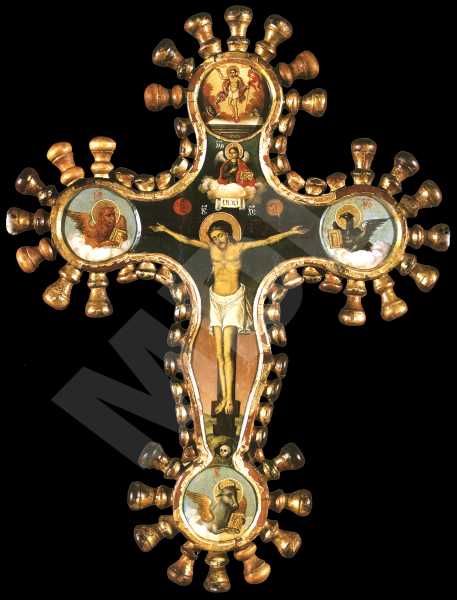Supraiconostasic Crucifix
Type:
Plastic iconographical object:
Cross
Period:
1834 year
Dimiter T. Molerov, born in 1780 in Bansko, son of Toma Vishanov the Moler. One of the best-known painters, a representative of the Bansko school of art, a disciple of his father, influenced by the art of Athos. Author of the murals of the naos in the St Archangels' paraclete in the Rila monastery, the murals in the Church of the Assumption of the Virgin in the Pchelino dependance. In 1840 and 1841 together with his son Simeon Molerov he paints the murals and the sponsors' portraits in St. Nicholas' and St. John of Rila's paracletes in the principal church in the Rila monastery. Among D. Molerov's major achievements in iconography are the following icons: St. Nicholas (1816) from St. Archangel Michael's church in the village of Leshko, Christ All-triumphant with Angels and Cherubim (1833), The Nativity and a Crucifixion from St Elijah the Prophet's church in the village of Usenovo. He has also worked in Belgrade on an invitation by Prince Milosh Obrenovich of Serbia. He died in 1870 in Bansko.
Dimmensions (cm):
53
/ 33
/ 2.5
Location
Country: Bulgaria
Province: Blagoevgrad
Town: Bansko
Museum: Museum complex
Source
Country: Bulgaria
Province: Blagoevgrad
Village: Gostun
Church: St. Prophet Elijah
Object identification notes
Dimiter Molerov (?)
Description
The representation is a two-sided one. On the one side is the "Crucifixion of Christ". In the center of the composition is the crucified figure of Christ, and painted on his both sides and below are the four symbols of the Evangelists, and at the upper end - the scene of "Christ's Resurrection". Treated on the other side is the theme of the "Epiphany" (Baptism of Christ). In the center is Christ, on his left-hand side is Saint John the Baptist, and on both sides there are two angels with towels in their hands. Painted up above is God Sabaoth, and inscribed down below are the names of the donors and the year of the donation.
Iconographical technique: Carving
A painting on a wood-canved oak in which the basic tones have been applied with distemper paints, and the finishing line-work - with oil paints. The layer of the painting is gided in the "Christ's Crucifixion" scene.
Base material: Wood
The ground coat is of plaster, about 1 mm thick, paper having been pasted over the places of the joints.
State, restoration traces and comments
There are no traces of any previous restorative intervention.
The guilding is badly rubbed off along the frame and over the wood-carved ornaments of the creoss.


